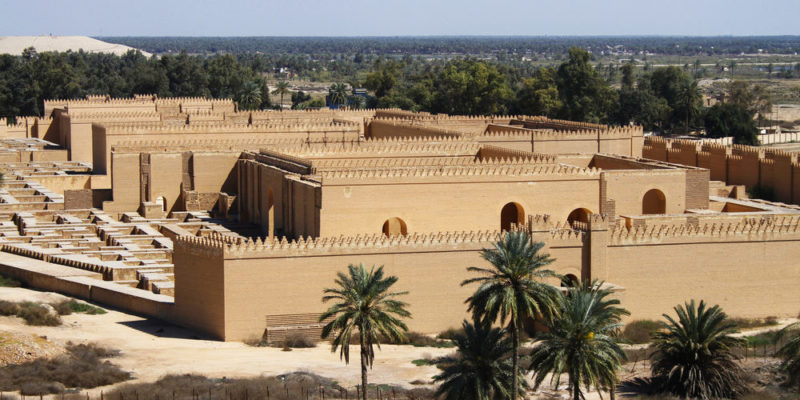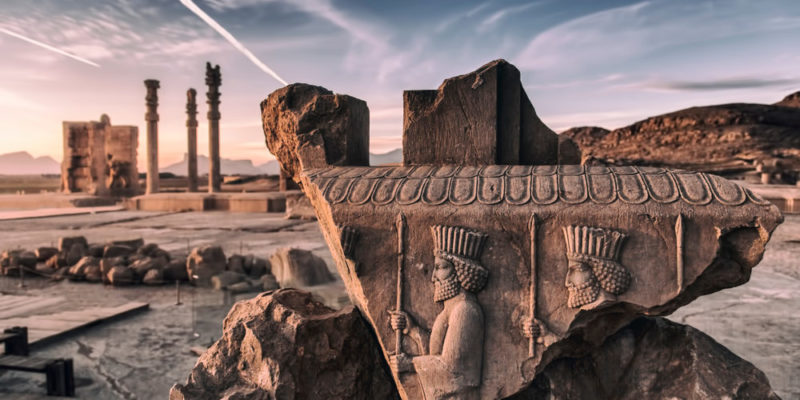We explain what Mesopotamia is, its characteristics and its inhabitants. Also, the arts and disciplines, your religion and more.
What is Mesopotamia?
Mesopotamia is a territory lying between the Tigris and Euphrates rivers, also known as the Middle East (present-day region of Iraq), encompassing parts of southwestern Asia and lands around the eastern Mediterranean Sea. The term Mesopotamia means "land between rivers". It turned out to be a very fertile area that allowed the first agricultural activities to be carried out.
The cultures of Ancient Egypt developed along the Nile River , around the same time as the cultures of Mesopotamia. For this reason, the oldest architectural works in the world are found in Mesopotamia and Egypt.
The main events that marked the transition between the periods of Prehistory and the Ancient Age were the creation of the wheel (around 3500 BC) and the development of writing (from 3300 BC) which practiced by the first sedentary peoples.
Characteristics of Mesopotamia

Mesopotamia was characterized by being established in the vicinity of two large rivers, which supplied the extensive river valley. Thanks to this condition, the area stood out for its very fertile land. These natural conditions were the basis of the economy of the region, through agriculture and animal husbandry, activities that allowed a sedentary life.
The Mesopotamian relief presents four types of variants:
- Plateaus . They are plateaus that extend in the Upper Mesopotamia region and cross it from east to west.
- plains. They are large extensions of flat land that extend in the Lower Mesopotamia area, from Baghdad to the Persian Gulf.
- mountains . They are great elevations of the land that manage to form the Lebanon mountain ranges, the Anti-Lebanon mountain range and the Amanus and Armenian mountains.
- Steppes and deserts . They are areas of vegetation adapted to drought due to low rainfall, so agriculture cannot be practiced. They extend in the Middle Euphrates Valley area.
Settlers of Mesopotamia
 The Sumerians settled in Lower Mesopotamia around 3500 BC. C. and founded the first cities. The most important during the first millennium was the city of Uruk, although the cities of Uy and Nipur also stood out.
The Sumerians settled in Lower Mesopotamia around 3500 BC. C. and founded the first cities. The most important during the first millennium was the city of Uruk, although the cities of Uy and Nipur also stood out.As more populations developed , numerous confrontations occurred motivated by the conquest of the territories. In the year 2334 a. C. the Akkadian empire managed to dominate the Sumerians and expand throughout Mesopotamia for 140 years. As a consequence, there was a cultural change in the region, among other issues, due to the spread of the Akkadian language.
Later, southern Mesopotamian was populated by the Babylonians and the Chaldeans who remained there until 533 AD. C. after being conquered by the Persians under the command of King Cyrus. The Persians managed to dominate a vast territory, which is today the region of Iran.
The region of Upper Mesopotamia was inhabited by the Assyrians, whose capital was Assur (the same name as their main deity), on the banks of the Tigris River. They stood out for being the first to use iron weapons and cavalry, in wars.
Mesopotamian Culture
 The cultures of Mesopotamia encompassed different disciplines, such as:
The cultures of Mesopotamia encompassed different disciplines, such as:
- Architecture: They created the brick and managed to revolutionize construction, especially that of pyramid-shaped temples and palaces. For example, the important religious center of Ziggurat of Borshipa, near Babylon.
- Mathematics: They created weight measures called mina (equivalent to 305 grams) and talent (equivalent to 60 mines). In addition, they used measures of length, such as the elbow (which was equivalent to 49 centimeters).
- Astronomy: They studied the sky in depth. They made observations that were a great advance for astronomy. They managed to calculate the day in 24 hours, the week in 7 days and the year in 12 months, they identified the eclipses of the Sun and the Moon and created the 12 signs of the zodiac.
- Writing: They created the first writing system, called "cuneiform" because the signs were made up of lines shaped like nails or wedges. The signs consisted of drawings of animals and objects. They wrote with a stylus on small tablets of soft clay which they then hardened.
- The Hammurabi code: They created a collection of laws during the reign of Hammurabi, a Babylonian monarch, in the 17th century BC. C. This document called "the code of Hammurabi" was the oldest legal document. Some of the laws written in stone could not be changed even by other kings .
Mesopotamian Religion
 Mesopotamian religion was characterized as polytheistic , although it had three main gods: Eam (the god of wisdom and magic), Anu (the two of heaven), and Enlil (the god of earth, storms, and agriculture).
Mesopotamian religion was characterized as polytheistic , although it had three main gods: Eam (the god of wisdom and magic), Anu (the two of heaven), and Enlil (the god of earth, storms, and agriculture).This region has been of great influence, both in Christianity and in Islam. Stories such as the Garden of Eden, the Great Flood, and the Creation of the Tower of Babel have been part of the writings of the Bible .
Other gods corresponded to natural phenomena, such as Sin (the god of the moon), Abad (the god of storms and rain) and Shamash (the god of the sun). They considered that the gods lived far from the world of humans.
The above content published at Collaborative Research Group is for informational and educational purposes only and has been developed by referring to reliable sources and recommendations from experts. We do not have any contact with official entities nor do we intend to replace the information that they emit.
Cultural journalist with great interest in education and technological innovation in the classroom. The future passes through technology and it is already here. .
Leave a reply
Your email address will not be published. Required fields are marked *Recent post

Sport: What Is It, Types, Risks, Features, Characteristics and Examples

Dogs: Emergence, Features, Characteristics, Feeding and Breeds

Story: Definition, Elements, Structure, Features and Characteristics

